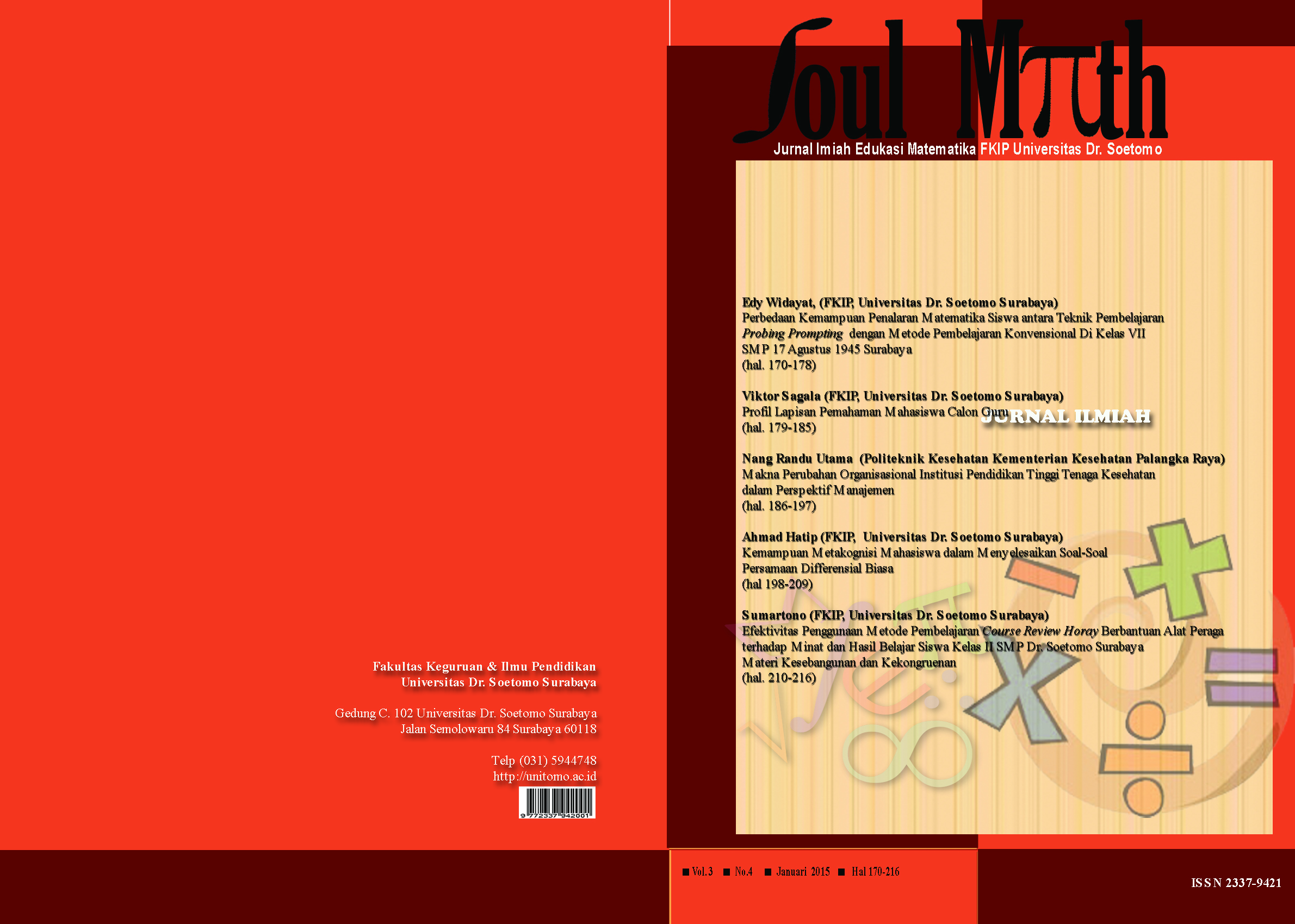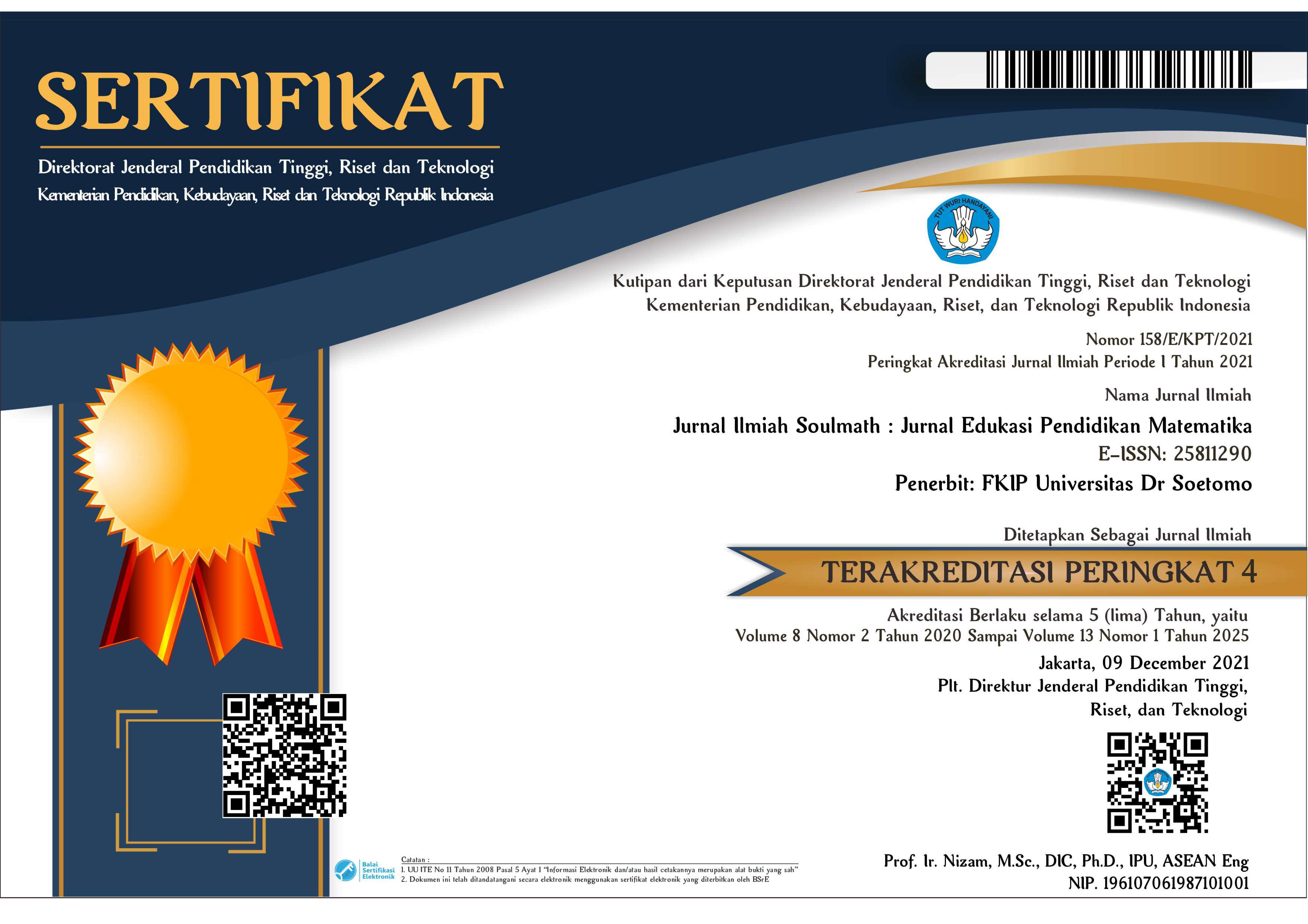PROFIL LAPISAN PEMAHAMAN MAHASISWA CALON GURU
 Abstract views: 391
,
Abstract views: 391
,
 PDF (Bahasa Indonesia) downloads: 582
PDF (Bahasa Indonesia) downloads: 582
Abstract
At the end of the decade was diverse any researches has been done regarding understanding. Pegg and Tall (2005) identified two types of theories of cognitive growth of global and local. Dubinsky with APOS theory (action, process, object, scheme), Pirie & Kieren with the model of understanding.layer (level). Pirie &Kieren (1994) has provided a theoretical framework of eight levels (layers) of understanding, namely; i) primitive knowing, ii) image making, iii) image having, iv) property noticing, v) formalizing, vi) observing, vii) structuring and viii) inventising. Martin (2008) describes a framework in folding back the three elements, namely i) the source of folding back, ii) the form of folding back and iii) the results of folding back. Guided by the model Pirie & Kieren and indicator of the form of folding back of Martin, research was conducted on student teachers. Devices in the interview given problem based task is to find the derivative of function f(x) = (2x + 4)4(1-3x)5. After the interview was analyzed, be concluded that: 1. The subject with high-math capable outermost achieving layer of understanding that inventising. This subject meets the indicators understanding of image making, image having, property noticing, observing, formlising, structuring. Even up to the last layer of the subjects had a complete understanding of the derivative function structured form of the product of two polynomial functions, answering questions, write and explain the application of the concept of the derivative function in Physics. 2. The subject of being reached lining mathematical capable outermost achieving layer of understanding primitive knowing, not reaching the formalizing because he only uses derivative chain rule function composition, but are not able to mention the name of the rule. This subject did folding back form "cause discontinuous".3.The subject lower mathematical ability is not on the innermost layer (primitive knowing)
Downloads
References
Droujkova, Maria. 2011. Fraction interactives seminar study group. Technology for Mathematics Education course.
Droujkova, A., Berenson,B, Slaten,K. & Tombes,S. 2011. A Conceptual Framework for Studying Teacher Preparation: The Piere-Kieren Model, Collective Understanding and Metafor. Proceding of the 29th Converence of the International Group for the Mathematical Education. Volume 2:289-296
Dubinsky & McDonald. 2001. APOS: A Constructivist Theory of Learning in Undergraduate Mathematics Education Research. Dalam D.Holton (Ed.)
The Theaching and Learning of Mathematic at University Level: An ICMI Study (hlm 273-280) Dordrecht, NL:Kluwer
Dubinsky, E & Wilson,Robin. 2013. “High School Students’ Understanding of the Function Concept”. the Journal of Mathematical Behavior 32 (2013) 83 101. For a pre-publication draft PDF. http://www.sciencedirect.com/science/article/pii/S0732312312000582
Katsberg(2002) Understanding Mathematical Concepts : The Case of University Logaritmic Function. Dissertation. Departement of Mathematics Lulea.Online.http:/jwilson.coe.uga.edu/pers/katsberg_signe_e_200205_phd.pdf, diakses 20-01-2015
Maharaj, A. 2003. An APOS Analysis of Students’ Understanding of the Concept of a Limit of a Function , School of Mathematical Sciences University of KwaZulu-Natal.http://www.amesa.org.za/amesap_n71_a5.pdf
Manu. 2005. Language Switching and Mathematical Understanding in Tongan Classrooms: An Investigation. Journal of Educational Studies. Vol 27, Nomor 2 diakses 6 Maret 2015
Martin, Croix&Fownes. 2005. An Exploration of the Growth in Mathematical Understanding of Grade 10 Learners, M.Ed (Mathematics Education). Faculty Of Humanities (School of Education) at the UNIVERSITY OF LIMPOPO Online diakses 20 Jnuari 2015
Martin, Lyndon. 2008. Folding Back and Growth of Mathematical Understanding in Workplace Training, dimuat dalam Journal online Research Gate http://www.researchgate.net/publication/239918621_Folding_Back_and_the_Growth_of_Mathematical_Understanding_in_Workplace_Training. diakses 20 Januari 2015
Martin, C & Piere, S. 2000. The Role of Collecting in the Growth of Mathematical Understanding. Mathematical Education Research Journal 2000, Vol 12, no 2:127-146
Meel, D.E. 2003. Model and Theories of Mathematical Understanding: Comparing Piere-Kieren’s Model of the Growth of Mathematical Understanding and APOS Theory. CMBS Issues in Mathematical Education.Volume 12, 2003
Moleong,J. 2010. Metodologi Penelitian Kualitatif. Edisi Revisi. Bandung. PT Remaja Rosdakarya
Mousley, J. 2005 What Does Mathematics Understanding Look Like? Makalah disajikan pada Annual Converence Held at RMIT, Melbourne, 7-9 Juli 2005 (Online), (www.merga.net.au/documents/RP622995.pdf). Diakses 12 Januari 2015.
Parameswaran, R. 2010. Expert Mathematicians Approach to Understanding Definition. The Mathematic Educator Vol 20, Number I:45-51
Pegg, J. & Tall, D. 2005. The fundamental cycle of concept construction underlying various theoretical frameworks. Proceedings of PME Volume 37, Issue 6, pp 468-475 Online http://link.springer.com/article/10.1007/BF02655855#page-2
Piere,S.&Kieren,T. 1994. Growth in Mathematical Understanding: How we Can Characterize it an How can Represent it. Education Studies in Mathematics Volume 9:160-190
Santos ,A.G, Thomas, M.O.J. 2003. The Growth of Schematic Thinking about Derivative. The Journal of Mathematical Education University of Auckland
Skemp, R. 1976. Relational Understanding and Instrumental Understanding. Mathematics Teaching. 77:20-26
Skemp, R. 1987. Symbolic Understanding: Mathematics Teaching. 99:59-61
Slaten. 2006. Effective Teaching and Uses of Instructional Representations in Secondary Geometry : A Comparison of Novice an An Experianced Mathematics Teacher. Dissertation North Carolina State University. Online. http://respository.lib.ncsu.edu/ir/bitstream/1840.16/5481/1/etd.pdf, diakses 10-02-2015
Susiswo. 2014. Folding back Mahasiswa dalam Menyelesaikan Maslah Limit, Disertasi, Universitas Negeri Malang. Jurnal online. http://teqip.com/wp-content/uploads/2014/12/MATEMATIKA-1-hal.-1-153.pdf diakses 10-02-2015
Tall, D. 1993. The Transition from Arithmetics to Algebra: Numbers Patterns of Proceptual Programming? New Directions in Algebra Education, Queensland University of Teachnology, Brisbane, 213-231







